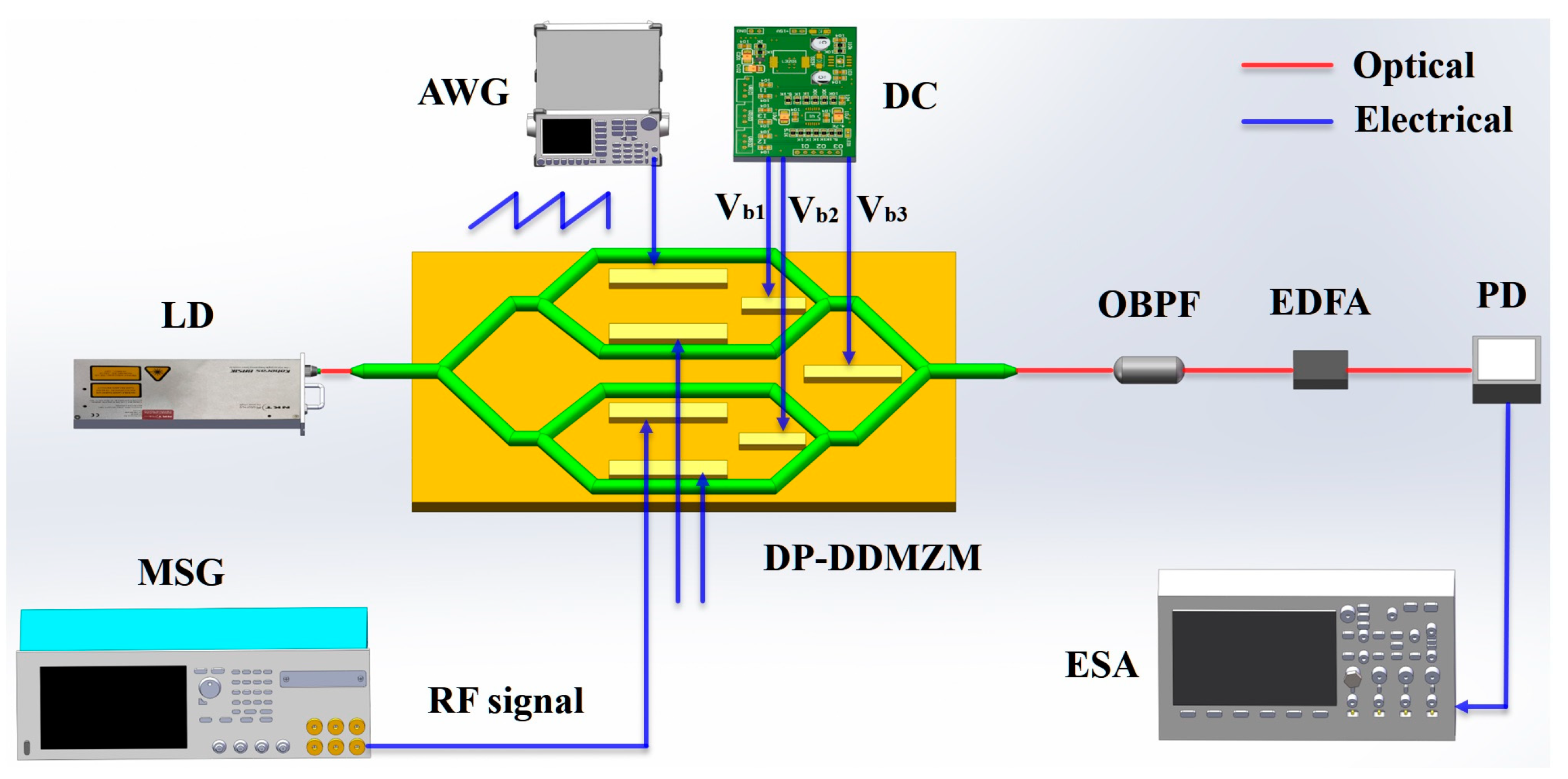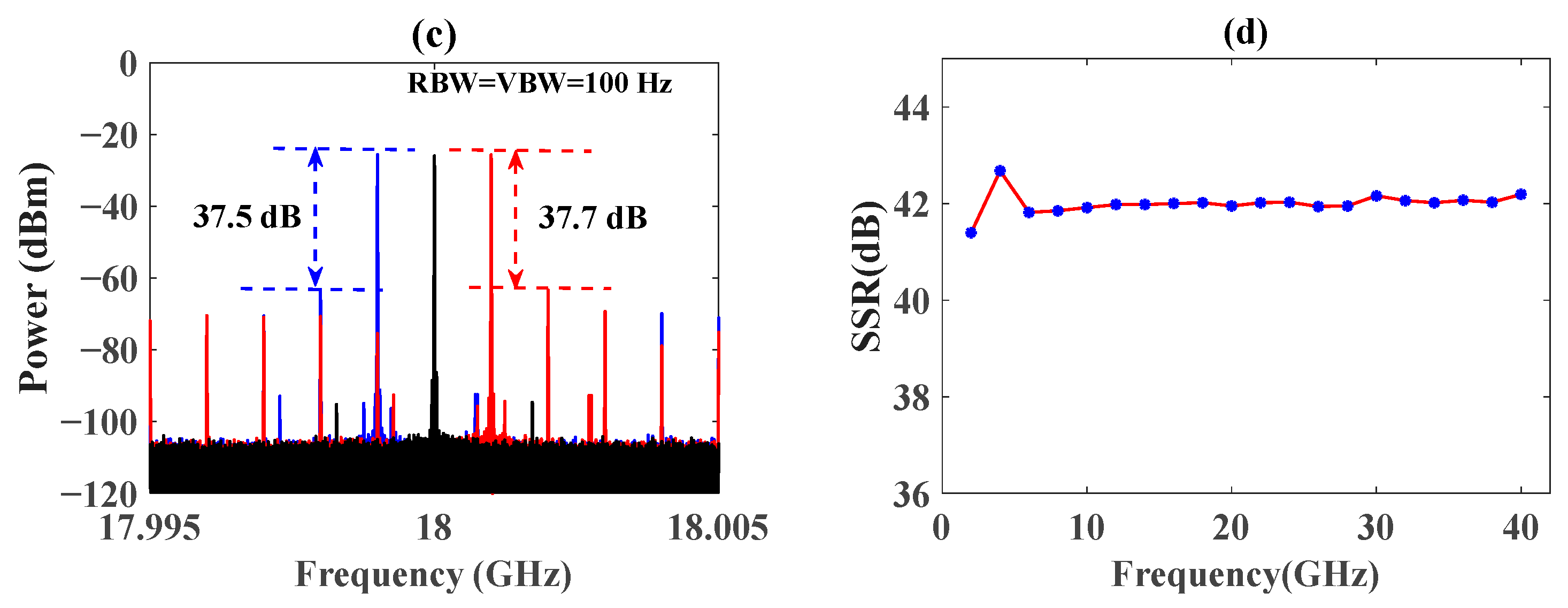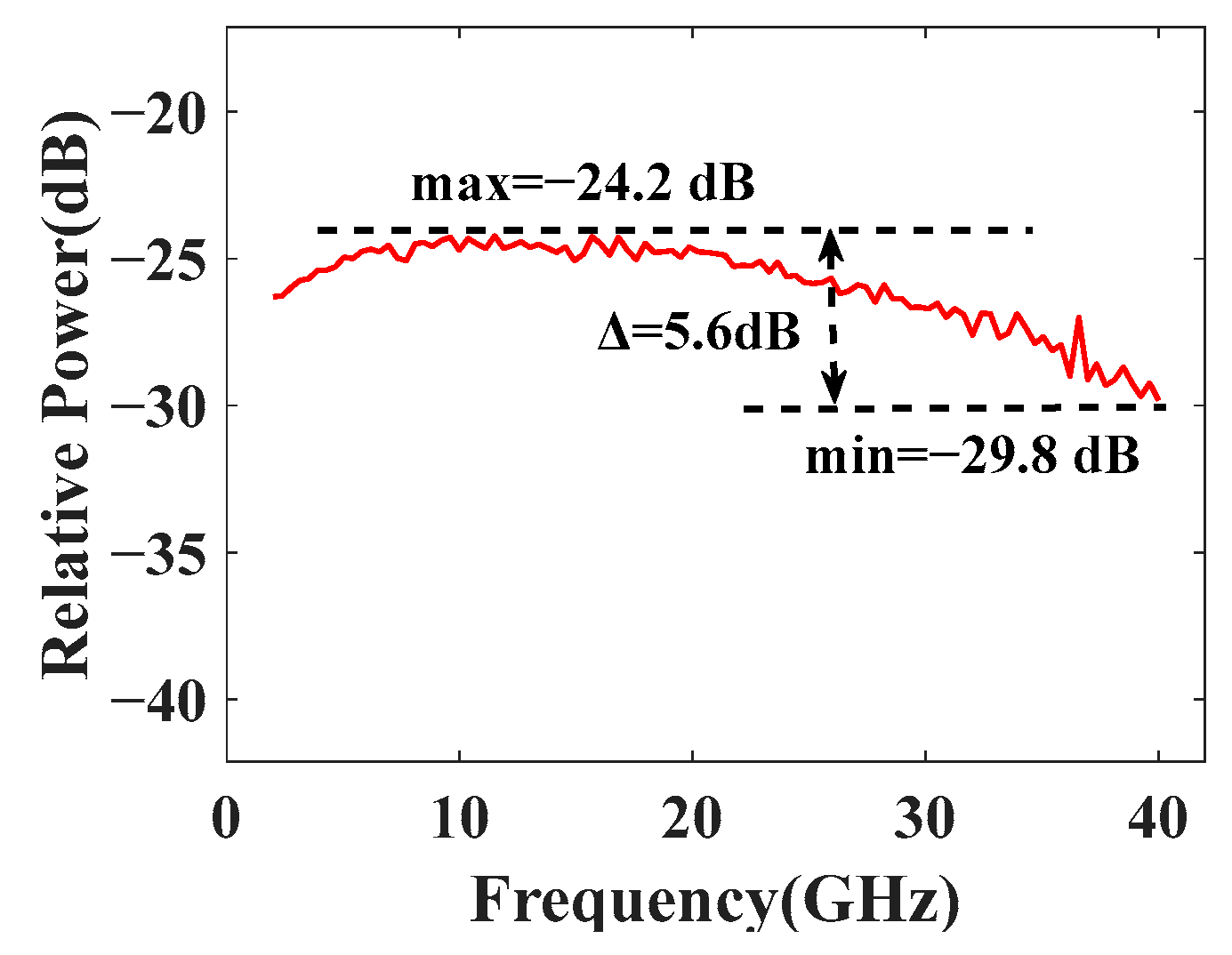Microwave Photonics Broadband Doppler Velocity Simulator with High Spurious Suppression Ratio by Using Serrodyne Modulation
Abstract
1. Introduction
2. Principles and Methods
2.1. Doppler Frequency Shift Principle
2.2. Pre-Distortion Compensation of the Sawtooth Wave
3. Results
3.1. Doppler Frequency Shift and SSR Measurement
3.2. Operational Bandwidth Measurement
3.3. Doppler Velocity Simulation Errors
4. Conclusions
Author Contributions
Funding
Institutional Review Board Statement
Informed Consent Statement
Data Availability Statement
Conflicts of Interest
References
- Du, L.; Sun, Q.; Bai, J.; Wang, X.; Xu, T. Speed calibration and traceability for train-borne 24 GHz continuous-wave Doppler radar sensor. Sensors 2020, 20, 1230. [Google Scholar] [CrossRef] [PubMed]
- Shao, J.; Chen, W.; Shen, X.; Pan, J.; Zhao, C.; Zhao, C. Development of Verification Device for Multitarget Radar Development of Verification Device for Multitarget Radar. J. Sens. 2022, 2022, 7365881. [Google Scholar]
- Du, L.; Sun, Q.; Cai, C.; Bai, J.; Fan, Z.; Zhang, Y. A vehicular mobile standard instrument for field verification of traffic speed meters based on dual-antenna doppler radar sensor. Sensors 2018, 18, 1099. [Google Scholar] [CrossRef] [PubMed]
- Cumming, R.C. The serrodyne frequency translator. Proc. IRE 1957, 45, 175–186. [Google Scholar] [CrossRef]
- Guan, Z.; Chen, Y.; Lei, P.; Li, D.; Zhao, Y. Application of hash function on fmcw based millimeter-wave radar against DRFM jamming. IEEE Access 2019, 7, 92285–92295. [Google Scholar] [CrossRef]
- Wang, C.; Hu, W.; Geng, Z.; Zhang, J.; Zhu, D. Parameter estimation for interrupted sampling repeater jamming based on ADMM. Sensors 2021, 21, 8277. [Google Scholar] [CrossRef] [PubMed]
- Wu, Z.; Grbic, A. Serrodyne Frequency Translation Using Serrodyne Frequency Translation Using. IEEE Trans. Antennas Propag. 2020, 68, 1599–1606. [Google Scholar] [CrossRef]
- Liu, W.; Meng, J.; Zhou, L. Impact analysis of DRFM-based active jamming to radar detection efficiency. J. Eng. 2019, 2019, 6856–6858. [Google Scholar] [CrossRef]
- Mehdizadeh, F.; Soroosh, M.; Alipour-Banaei, H.; Farshidi, E. A novel proposal for all optical analog-to-digital converter based on photonic crystal structures. IEEE Photonics J. 2017, 9, 4700311. [Google Scholar] [CrossRef]
- Xu, Y.; Li, S.; Xue, X.; Xiao, X.; Zheng, X.; Zhou, B. An interleaved broadband photonic adc immune to channel mismatches capable for high-speed radar imaging. IEEE Photonics J. 2019, 11, 5502009. [Google Scholar] [CrossRef]
- Yao, J. Microwave photonic systems. J. Lightw. Technol. 2022, 40, 6595–6607. [Google Scholar] [CrossRef]
- Pan, S.; Ye, X.; Zhang, Y.; Zhang, F. Microwave photonic array radars. IEEE J. Microw. 2021, 1, 176–190. [Google Scholar] [CrossRef]
- Nguimdo, R.M.; Saleh, K.; Coillet, A.; Lin, G.; Martinenghi, R.; Chembo, Y.K. Phase Noise Performance of Optoelectronic Oscillators Based on Whispering-Gallery Mode Resonators. IEEE J. Quantum Electron. 2015, 51, 6500308. [Google Scholar] [CrossRef]
- Lu, Z.H.; Charrett, T.; Ford, H.; Tatam, R. Mach–Zehnder interferometric filter based planar Doppler velocimetry (MZI-PDV). J. Opt. A Pure Appl. Opt. 2007, 9, 1002. [Google Scholar] [CrossRef]
- Huang, L.; Li, R.; Chen, D.; Xiang, P.; Wang, P.; Pu, T.; Chen, X. Photonic downconversion of RF signals with improved conversion efficiency and SFDR. IEEE Photonics Technol. Lett. 2016, 28, 880–883. [Google Scholar] [CrossRef]
- Wang, Y.; Li, J.; Zhou, T.; Wang, D.; Xu, J.; Zhong, X.; Yang, D.; Rong, L. All-optical microwave photonic downconverter with tunable phase shift. IEEE Photonics J. 2017, 9, 5503408. [Google Scholar] [CrossRef]
- Yang, F.; Wang, D.; Wang, Y.; Chen, Z.; Zhou, T.; Yang, D.; Zhong, X.; Zhang, H. Photonics-assisted frequency up/down conversion with tunable OEO and phase shift. J. Lightw. Technol. 2020, 38, 6446–6457. [Google Scholar] [CrossRef]
- Tang, Z.; Pan, S. A filter-free photonic microwave single sideband mixer. IEEE Microw. Wirel. Compon. Lett. 2016, 26, 67–69. [Google Scholar] [CrossRef]
- Winnall, S.T.; Lindsay, A.C.; Knight, G.A. A wide-band microwave photonic phase and frequency shifter. IEEE Trans. Microw. Theory Tech. 1997, 45, 1003–1006. [Google Scholar] [CrossRef]
- McDermitt, C.S.; Bucholtz, F. RF frequency shifting via optically switched dual-channel PZT fiber stretchers. IEEE Trans. Microw. Theory Tech. 2005, 53, 3782–3787. [Google Scholar] [CrossRef]
- Chen, Z.; Zhong, X.; Liu, J.; Li, W.; He, Z.; Wang, M.; Chen, J.; Zhou, T. A serrodyne frequency translator with wide-band and high precision based on paralleled PM and DP-MZM. Proc. SPIE 2019, 11068, 1106813. [Google Scholar]
- Huang, C.; Chan, E.H.W. Photonics-based serrodyne microwave frequency translator with large spurious suppression and phase shifting capability. J. Lightw. Technol. 2021, 39, 2052–2058. [Google Scholar] [CrossRef]
- Salzenstein, P.; Pavlyuchenko, E. Uncertainty Evaluation on a 10.52 GHz (5 dBm) Optoelectronic Oscillator Phase Noise Performance. Micromachines 2021, 12, 474. [Google Scholar] [CrossRef] [PubMed]







Disclaimer/Publisher’s Note: The statements, opinions and data contained in all publications are solely those of the individual author(s) and contributor(s) and not of MDPI and/or the editor(s). MDPI and/or the editor(s) disclaim responsibility for any injury to people or property resulting from any ideas, methods, instructions or products referred to in the content. |
© 2024 by the authors. Licensee MDPI, Basel, Switzerland. This article is an open access article distributed under the terms and conditions of the Creative Commons Attribution (CC BY) license (https://creativecommons.org/licenses/by/4.0/).
Share and Cite
Liu, Z.; Wang, D.; Zhu, W.; Zhang, J.; Wang, Y.; Yao, J.; Zhang, Y. Microwave Photonics Broadband Doppler Velocity Simulator with High Spurious Suppression Ratio by Using Serrodyne Modulation. Photonics 2024, 11, 357. https://doi.org/10.3390/photonics11040357
Liu Z, Wang D, Zhu W, Zhang J, Wang Y, Yao J, Zhang Y. Microwave Photonics Broadband Doppler Velocity Simulator with High Spurious Suppression Ratio by Using Serrodyne Modulation. Photonics. 2024; 11(4):357. https://doi.org/10.3390/photonics11040357
Chicago/Turabian StyleLiu, Zhe, Dayong Wang, Weimin Zhu, Jing Zhang, Yunxin Wang, Jinchuan Yao, and Yu Zhang. 2024. "Microwave Photonics Broadband Doppler Velocity Simulator with High Spurious Suppression Ratio by Using Serrodyne Modulation" Photonics 11, no. 4: 357. https://doi.org/10.3390/photonics11040357
APA StyleLiu, Z., Wang, D., Zhu, W., Zhang, J., Wang, Y., Yao, J., & Zhang, Y. (2024). Microwave Photonics Broadband Doppler Velocity Simulator with High Spurious Suppression Ratio by Using Serrodyne Modulation. Photonics, 11(4), 357. https://doi.org/10.3390/photonics11040357




